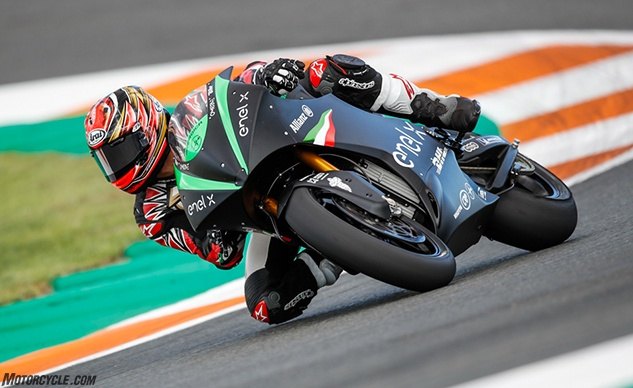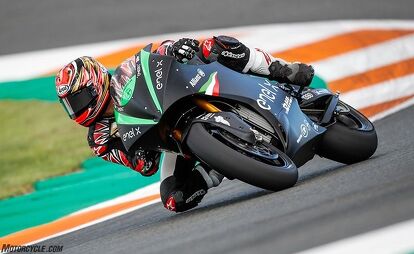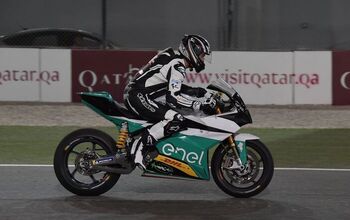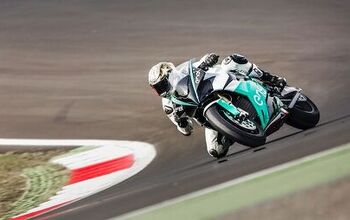Testing a MotoE Racer: The Energica Ego Corsa

Riding a 560-pound Moto3 racer
As we come to the end of 2019 and the conclusion of the first MotoE season, I think it’s fair to say the debut of Energica’s Ego Corsa MotoE electric racer was a success. Each race produced close battles (usually for the lead), the bikes go plenty quick, and though the sound of internal combustion is missing, it’s replaced with a soundtrack all its own. I like to think of it as the racing soundtrack of the future.
Much of the credit for this goes to the hard-working (and minimal, numbering fewer than 70 full-time employees) crew at Energica, whose determination wouldn’t let them fail, especially in the face of a massive charging station fire that burned down all 18 motorcycles during preseason testing. But Energica was able to build 18 more bikes, plus a few spares, with only a minimal change to the original schedule. I don’t care who you are, that’s impressive.
With the season over and (most of) the 18 Ego Corsas still intact, I was one of the few journalists from around the world lucky enough to get an invite from Energica to try the Ego Corsa for myself at the Ricardo Tormo circuit in Valencia, the day after the MotoGP (and MotoE) season finale. It was an opportunity not to be missed, especially as I’ve been developing and racing another electric motorcycle, the Lightfighter LFR19, all season – a motorcycle that, arguably, could give the Ego Corsa a run for its money. Being able to ride the two would give me a unique perspective nobody in the world can copy, and an opportunity like this certainly wasn’t lost on me. To get yourself up to speed on the Lightfighter, read parts one and two of our adventure here and here.
The Bike
Before getting into the actual riding impressions, it’s worth talking about the specs of the Ego Corsa. Even to the trained eye, it’s easy to pass off the bike as a production Energica Ego with better suspension and race bodywork. In reality, the Ego Corsa is based on the standard Ego as far as geometry and basic structures go, but that’s about it; The battery, motor, software, and even the casting of the frame and swingarm are different.
Sans bodywork, the Ego Corsa obviously looks far different than your stripped-down combustion motorcycle, but in this case, the eye can’t help but narrow in on the massive battery. Because it is a race bike after all and the company doesn’t want to give too many of its trade secrets away, Energica CTO Giampiero Testoni would only admit to a battery capacity of “over 20kWh, nominal,” which coincidentally aligns with the bump in battery capacity for the production bikes of 21.5kWh – making them the largest production e-bike batteries currently available.
Getting back to the Ego Corsa however, the battery consists of Nickel Cobalt Maganese (NCM) pouch cells, not too dissimilar from what you’d find in other EVs in the automotive world. It’s wrapped by a trellis frame, which is basically the norm for Italian motorcycles. As for its sheer size, Testoni revealed that, in discussions with Dorna about the new MotoE series, both sides agreed the motorcycles would be able to run at full power throughout the course of the (approximately 8-lap) race, thus eliminating the need to ride strategically (read: slower) in the middle of a race to save energy for the end. More on this later.
With the battery in place, the motor is packaged tightly directly behind the battery, with the controller resting atop the battery. Data collection and communication to the rider from Dorna is handled by Dell’Orto, who produce data collection and communication units for the spec bikes. Together, the big motor/controller combo puts out about 400 amps of current to get the 570-pound motorcycle down the front straight of certain tracks at 150 miles per hour. No, neither the weight or speed numbers were typos. The bike has to be quick, obviously, if it’s going to compete at this level, and Energica determined there simply wasn’t anywhere else to put everything.
Considering my time with the Lightfighter electric racer, and its geometry-first design philosophy, the tight packaging of the three main components of the Ego Corsa illustrates the challenge posed when a large battery dictates where everything else will live. The motor, for example, resides in the spot you’d normally find a shock. As a result, the MotoE bike’s shock is directly mounted, offset to the right, without a linkage between swingarm and chassis, thus limiting the potential for tunability and adjustments.
The Test
This geometry discussion is a good transition to the actual test ride of the Ego Corsa MotoE racer. The gameplan was straightforward, if not brief: I’d get an out-lap, five hot laps, then an in-lap, for a total of nearly seven laps. In that time I’d have to re-familiarize myself with a track I hadn’t seen in several years, get accustomed to the Ego Corsa, then try to go somewhat quickly – not only to form impressions about the bike, but also to ensure the super-soft Michelin tires (the same used in MotoGP) stayed in their optimum temperature range. Of course, the cardinal rule lingered above us all: Do. Not. Crash.
If the number 15 written on the tech inspection sticker on the frame was any indicator, I’d be riding Sete Gibernau’s bike (yeah, remember him?). Immediately what’s surprising is how high the seat is perched. The butt-up, head-down approach clearly favors keeping weight on the front, but my toes barely touched the ground. This is hardly a concern once you get going, and once you do, two things make themselves perfectly clear: 1. The Ego Corsa is quick, and 2. The Ego Corsa is heavy.
First, the speed. When you twist the wrist and demand 400-plus amps of current draw, over 200nm (147.5 lb-ft.) of torque pushes you back in the saddle in an uncanny way and the 120kw (161 hp) keep you there. Traditional combustion engines require gears (inside a transmission, obviously) to keep the engine in its most efficient power band, and even with high-horsepower engines, while the power may be startling, it’s still relatively brief. We’ve subconsciously trained ourselves to get used to that power, but only in a narrow window before changing gears. Then once you change gears, the rush of acceleration starts all over again. Each time you shift there’s a momentary delay in power. However small that gap might be when the transmission changes from one gear to another, our brain has a microsecond to re-adjust.
With a high-power, single-speed electric like the Ego Corsa the rush you get, that sensation of the Earth scorching by you at an alarming rate, doesn’t let up from the moment you twist the throttle until the moment the motor can’t spin any higher (or the moment you tap out, whichever comes first). There are no gears to select to give your senses a moment to adjust. The best method of coping is to keep your eyes up so you can soak it all in. Once you wrap your head around the twist-n-go nature of the Ego Corsa, you learn that power comes on softly at the bottom and tapers at the top, but in the fat mid-range you understand what it means to have truly linear power delivery. Whatever degree your wrist moves will be met with an appropriate amount of power. And while I appreciate a finely executed shift as much as the next person, simply twisting the throttle and hanging on is a different kind of thrill.
So, too, is the sound – especially if you’re a spectator watching in person instead of on a TV or computer screen. Instead of loud, ferocious exhausts wailing past, when you have a gaggle of Ego Corsa’s at full tilt, not only can you hear the futuristic whine of the motors, but you can practically hear the motorcycles pierce holes through the air as they move past at high rates of speed, leaving you with the surreal sound of the turbulence and wake they leave behind.
Moving quickly is one thing, and it’s one thing the Ego Corsa does quite well. At some point you need to slow down and turn. It’s here where all of the bike’s 570 pounds introduce themselves to you. There’s no getting around the massive weight the Ego Corsa carries around, and it’s all you can do to squeeze the brake lever and rein it all in. It’s a lot of mass to huck into a corner, especially from side-to-side, but despite the heft, turn-in is predictable, and the bike feels planted on its side with good feedback.
The geometry issue spoken of earlier with the odd shock placement creeps up when it’s time to exit a corner, at least it did for me. While getting the bike back to vertical and applying power at the same time, the rear would occasionally pump under acceleration. It’s possible slowing the rebound damping would address this, but with only five laps at my disposal, this wasn’t happening. Besides, this was primarily occurring exiting slow-speed turns, I could ride around it, and there were plenty of other things to focus on.
And then, just as I was getting comfortable with the bike and the track, my five laps were up and it was time to bring her home. It was an interesting experience, and if the on-board lap timer was accurate, the best of my five laps was within ten seconds of the MotoE pole time just two days prior!
After the ride and a debrief with Testoni, I explained the weird pumping sensation I was feeling, to which he explained how the regular MotoE riders typically treat the throttle like an on/off switch (there’s no traction control on these bikes, mind you), steering with the rear and sometimes getting back on the throttle well before reaching the apex to allow the back to step out and place them on the desired line on the exit, already wide open. None of this rolling through the corner business and feathering back on the throttle like I was doing. It’s a weird hybrid riding style – as if Moto3 met flat track.
Interestingly, when asked how much battery is left after a race (all of which have been 7 laps this year), Testoni admitted the batteries come back with about 40% remaining – a staggeringly large number when generally you’d want to cross the finish line as close to empty as possible. The reason I was given was because of the necessity of running the entire race at full power. And while I can see some truth to this – the large battery means there’s less voltage sag at the end of a race – finishing a race with 40% battery left seems…wasteful.
Lightfighter Comparisons
Naturally, after riding the Ego Corsa, I couldn’t help but make comparisons to the Lightfighter LFR19 I’ve been racing this year – a motorcycle, let’s not forget, very much in the beta phase built by two guys in a workshop in their spare time. The most immediate difference is the weight. Being nearly 200 pounds lighter than the Ego Corsa, the Lightfighter’s 375 lbs feels feather-like in comparison, and that shows in every aspect of performance. Of course, much of this discrepancy can be attributed to battery capacity: the Energica carries twice as much as the Lightfighter (“over 20kWh” vs. 11kWh).
The Ego Corsa does have an advantage in the chassis/handling department. It’s certainly heavy and takes muscle to bend it into corners, but once you have it on its side it feels very stable, predictable, and communicative. Due to its overbracing, the Lightfighter lacks the finer levels of communication and chassis flex once all the way over. The trade-off being the lack of weight and how easy it is to toss it on its side.
From a power perspective, my butt dyno says both bikes deliver roughly the same levels of thrust. Other journalists, including those with racing backgrounds who sampled the Ego Corsa, were blown away by its performance. I suppose I would be, too, if I only had production electric motorcycles to benchmark. Judged by those metrics, the Ego Corsa will blow your doors off. But having the unique experience of racing the Lightfighter under my belt, I’d say both machines are roughly the equals of each other. Which is to say they’re freaking fast.
Beyond that, it’s hard to really compare the two considering I’ve had a whole season on one and only five laps on the other. If only Energica would lend me an Ego Corsa for a head-to-head test…
The Future
Having finished the inaugural MotoE season, Energica’s contract spans two more years. In that time, Energica will surely have updates and improvements to each successive model, weight being the primary factor the team will bring down. And while nothing was confirmed to me, my guess is this is one of the main reasons the battery is so large – in order to trim it back in future iterations. Battery tech will likely advance enough to where race distances can remain the same, no power will be lost, weight will come down, and as a result, so will lap times. All things Energica can boast.
Of course, a big breakthrough will be the evolution of solid state batteries, though it’s unlikely the viability for such an application – and the cost – will align in the next two years. That said, once the current contract with Dorna expires, it’s Testoni’s hope other manufacturers join MotoE and make it an open series, paving the way for new technologies like solid state batteries to be introduced as soon as possible. “You would think I’d want to be the only one with the [MotoE] contract,” he says, “but really I want what’s best for the sport. This is an open series.”

Troy's been riding motorcycles and writing about them since 2006, getting his start at Rider Magazine. From there, he moved to Sport Rider Magazine before finally landing at Motorcycle.com in 2011. A lifelong gearhead who didn't fully immerse himself in motorcycles until his teenage years, Troy's interests have always been in technology, performance, and going fast. Naturally, racing was the perfect avenue to combine all three. Troy has been racing nearly as long as he's been riding and has competed at the AMA national level. He's also won multiple club races throughout the country, culminating in a Utah Sport Bike Association championship in 2011. He has been invited as a guest instructor for the Yamaha Champions Riding School, and when he's not out riding, he's either wrenching on bikes or watching MotoGP.
More by Troy Siahaan






























































































Comments
Join the conversation
Troy, another great article!
Electric Vehicles: The answer to a question never asked.
Humans are interactive, not passive, beings.
May as well make love to a blowup doll. You'll get the same feedback, as an electric vehicle.